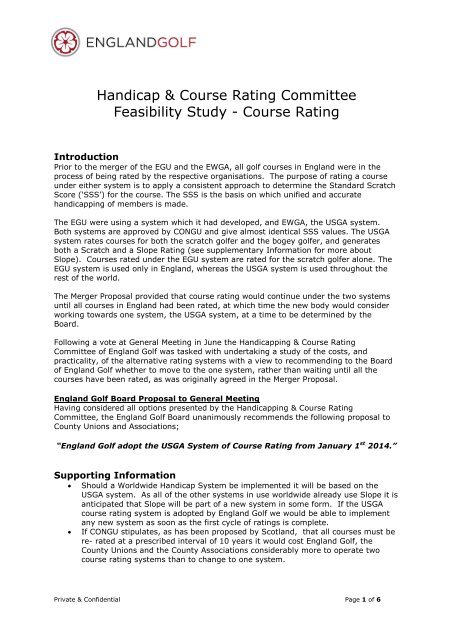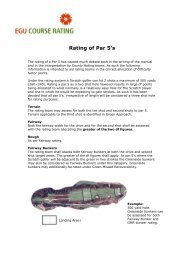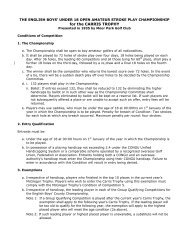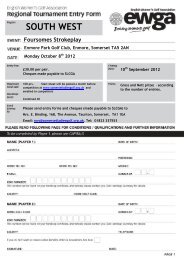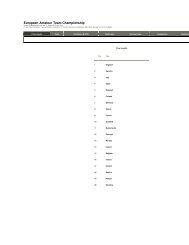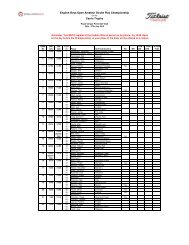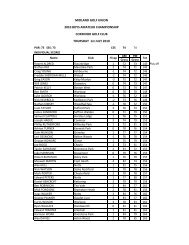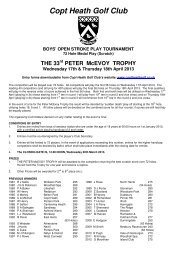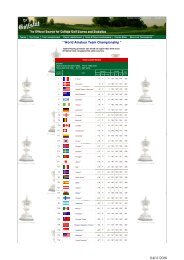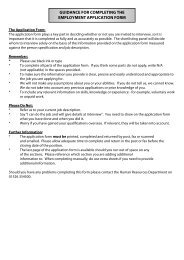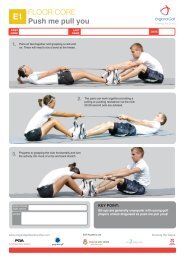Handicap & Course Rating Committee Feasibility ... - England Golf
Handicap & Course Rating Committee Feasibility ... - England Golf
Handicap & Course Rating Committee Feasibility ... - England Golf
- No tags were found...
Create successful ePaper yourself
Turn your PDF publications into a flip-book with our unique Google optimized e-Paper software.
There is a misapprehension that all ratings already completed under the EGUsystem would be redundant.Should USGA rating be adopted, all courses already rated will have a valid SSSuntil a re-rate under the USGA system within the 10 year cycle is required.Any courses not yet rated under the EGU system would be the first to be ratedunder the USGA system.Ideally course ratings for men and women would be synchronised so that thewomen complete their second cycle of ratings as the men complete their firstcycle. On that basis one team would rate each course. White tees would be ratedfor men only, but yellow and red tees could be rated for both men and women togive greater flexibility to golf clubs in relation to competition golf for all theirmembers.Implementation of Proposal1. Women’s course rating teams should continue the first cycle of ratings undercurrent funding arrangements.2. Men’s County Unions to have the option, until January 2014, to continue to ratecourses under the EGU system where required e.g. new courses or courses wheresignificant change has occurred, and according to the current fundingarrangements.3. County Lead Assessors to be identified early 20134. Training programmes in respect of the USGA system to be implemented by<strong>England</strong> <strong>Golf</strong> during 2013.Funding of ProposalThe Board recommends that,1. <strong>England</strong> <strong>Golf</strong> meets the costs associated with all training in respect of the USGAsystem, both for initial launch and ongoing.2. <strong>England</strong> <strong>Golf</strong> will fund the total cost of course rating at a set fee per club.Estimated Costs of ProposalTrainingInitial launch training costs to cover manuals/materials, staff and lead assessortraining - £35,000USGA required costs to cover onsite lead assessor training - £5000 (per annumfor the first 3 years) & £1000 per annum thereafter.<strong>Course</strong> <strong>Rating</strong>Projected costs under a single USGA course rating system.A single rating team will be required to rate all tees. White tees would be rated formen only, but yellow and red tees could be rated for both men andThere are approximately 2000 courses, and it is anticipated that 10% will be ratedeach year to achieve the required 10 year rating cycle.200 clubs rated at a cost of up to £100 per club - £20,000.(Costs based on a team of 3, travelling a round trip of 50 miles each @ 45p / mile+ a subsistence allowance of £9 each).Private & Confidential Page 2 of 6
Projected costs under the EGU and USGA separate course rating systemsExpenses x £100 x 200 x 2 = £40000 p.a, £400,000 for the 10 year cycle, andongoing.A separate rating team (whether, men, women or mixed) will be required to rateeach course under each systemAlthough at present the EGU system does not provide for courses to be re-rated every 10years, it is unlikely that this will continue to be acceptable to CONGU. Because equipmentchanges regularly and courses are lengthened with new tees, bunkering etc added, it ishighly likely that Scotland’s suggestion of re-rating every 10 years will be accepted.Mr Nigel EvansBoard Chairman, <strong>England</strong> <strong>Golf</strong>1 October 2012Private & Confidential Page 3 of 6
Slope <strong>Rating</strong>A "Slope <strong>Rating</strong>" is the USGA's mark that indicates the measurement of the relativedifficulty of a course for players who are not scratch golfers compared to the USGA<strong>Course</strong> <strong>Rating</strong> (e.g., compared to the difficulty of a course for scratch golfers). A Slope<strong>Rating</strong> is computed from the difference between the Bogey <strong>Rating</strong> and the USGA <strong>Course</strong><strong>Rating</strong>.The lowest Slope <strong>Rating</strong> is 55 and the highest is 155. A golf course of standard playingdifficulty has a Slope <strong>Rating</strong> of 113.Slope is currently not adopted by CONGU as it is considered that the application of theCSS negates the need for any further handicap adjustment under Slope. HoweverCONGU is the only authority worldwide not using Slope.Scratch <strong>Golf</strong>erA "scratch golfer" is a player who can play to a handicap of zero on any and all rated golfcourses. A male scratch golfer, for rating purposes, can hit tee shots an average of 250yards (based on the USGA System, 260 yards based on EGU System) and can reach a470-yard hole in two shots at sea level. A female scratch golfer, for rating purposes, canhit tee shots an average of 210 yards and can reach a 400-yard hole in two shots at sealevel.Bogey <strong>Golf</strong>erUnder the USGA system a "bogey golfer" is a player who has a <strong>Course</strong> <strong>Handicap</strong> ofapproximately 20 on a course of standard difficulty. He can hit tee shots an average of200 yards and reach a 370-yard hole in two shots at sea level. A female bogey golfer is aplayer who has a <strong>Course</strong> <strong>Handicap</strong> of approximately 24 on a course of standard difficulty.She can hit tee shots an average of 150 yards and reach a 280-yard hole in two shots.<strong>Rating</strong> TeamsThe team will comprise of at least one Lead Assessor (trained by <strong>England</strong> <strong>Golf</strong>) and atleast two assistants. A single rating team may comprise men, women or a combination ofboth. The team shall assess all tees for men’s and ladies SSS plus the Bogey rating (forinformation only, or until Slope is introduced).Worldwide <strong>Handicap</strong>ping System DiscussionDiscussions have taken place between the R&A and USGA with a view to developing aworldwide handicapping system. A formal meeting was held earlier this year, attended bythe R&A, USGA, CONGU, EGA (European <strong>Golf</strong> Association), GA(<strong>Golf</strong> Australia), RSA(South Africa) and Argentina. Also in attendance, and an indication of the perceivedimportance of the project, were Peter Dawson and Mike Davis, respective ChiefExecutives of the R&A and the USGA.There are 6 main systems in use at present. The goal is to work towards a core systemwith local variations worldwide. Everyone gave a presentation on their system, and whatthey felt was important locally. A new system will be based on USGA system, but notlock stock and barrel. However, if based on the USGA system the likelihood of someelement of Slope being incorporated is very likely. The USGA is aware of some of theinaccuracies generated by Slope in its current form and is prepared to address them.All representatives were requested to go back to their organisations then providefeedback to the R&A. All have now done so, and feedback has been positive.Private & Confidential Page 5 of 6
The core elements are to apply to all countries. The difficult discussions will be in respectof the local variations.Ten key principles have been agreed in order to take discussions further, and are set outin a document produced jointly by the R&A and the USGA as follows;KEY PRINCIPLES OF NEW, WORLDWIDE HANDICAPPING SYSTEM(DISCUSSION DRAFT 2)The system must:1. Enable as many golfers as possible to obtain and maintain a handicap.2. Enable golfers of differing ability, gender and nationality to transport theirhandicap to any golf course around the world and compete on a fair and equalbasis (achieve overall equitableness in the system).3. Indicate with sufficient accuracy the score a golfer is reasonably capable ofachieving on any course around the world, playing under average conditions.4. Provide for the monitoring and review of handicaps based on sufficient evidence ofa player’s game.5. Emphasise the importance of playing in accordance with the Rules of <strong>Golf</strong>.6. Reflect variations in playing conditions.7. Incorporate an element of flexibility or choice to reflect different golfing culturesaround the world, whilst adopting wherever possible a system of uniformcomponents.8. Be easy to understand and apply by golf clubs and golfing public and as economicas reasonably possible to install and operate.9. Have the confidence of the golfing public.10. Undergo a regular, co-ordinated review process by the leading authorities.Private & Confidential Page 6 of 6


